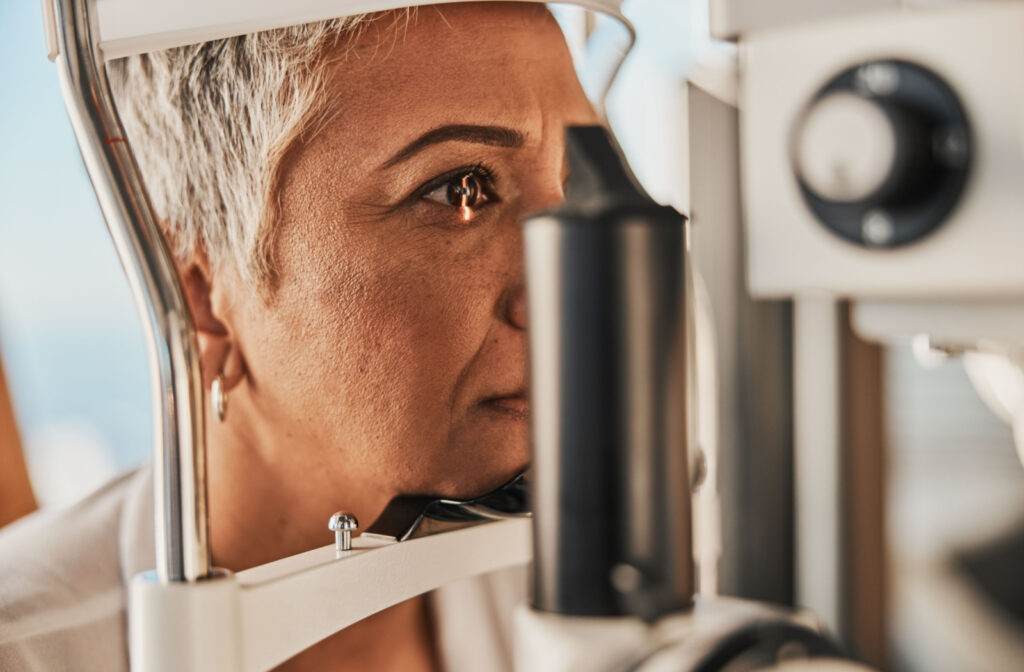Glaucoma is a disease that damages the optic nerve of the eyes, which can lead to vision loss and even blindness. It’s a common misconception that glaucoma only affects the elderly, but it can actually affect anyone regardless of age!
Glaucoma is a complex eye disease with various causes, including heredity. If a close relative has the condition, it may mean your chances of getting it as well are increased. While heredity plays a crucial role, there are several other factors to consider when it comes to your risk of developing glaucoma, which makes regular comprehensive eye exams vital for everyone.
The Types Of Glaucoma
Glaucoma is, in fact, a group of eye diseases. They’re often associated with increased pressure inside the eye, known as intraocular pressure (IOP), that damages the optic nerve and leads to vision loss.
Glaucoma can be classified into several types, each with unique characteristics and causes.
- Open-angle glaucoma: Open-angle glaucoma is the most common type of glaucoma. It occurs when the drainage canals in the eye become blocked, causing an increase in intraocular pressure. This type of glaucoma develops gradually and usually does not cause any symptoms until late in the disease’s development. If left untreated, it can lead to permanent vision loss.
- Angle-closure glaucoma: Angle-closure glaucoma occurs when the iris (the colored part of the eye) blocks the drainage angle in the eye, leading to a sudden increase in intraocular pressure. This type of glaucoma can cause severe eye pain, headache, nausea, and blurred vision. It’s considered a medical emergency that requires prompt treatment to prevent permanent loss of vision.
- Secondary glaucoma: Secondary glaucoma is caused by an underlying condition or injury that affects the eye’s drainage system. Some common causes of secondary glaucoma include eye surgery, eye injury, uveitis, medications such as corticosteroids, and other medical conditions like diabetes. It can develop gradually or suddenly, depending on the underlying cause.
- Normal-tension glaucoma: Normal-tension glaucoma occurs when there is damage to the optic nerve despite normal IOP. This type of glaucoma is often challenging to diagnose and requires several eye exams to determine the underlying cause of optic nerve damage. Unfortunately, experts aren’t 100% sure why this damage occurs.
In some very rare cases, glaucoma can affect infants and children. This is called congenital glaucoma, where a genetic abnormality, potentially inherited from the parents, affects the eye’s drainage system. Children with congenital glaucoma may have enlarged and cloudy eyes, light sensitivity, and excessive tearing.
Glaucoma Symptoms
In the early stages of glaucoma, you may not show any symptoms and may only realize the problem once your vision has been affected significantly. This is why it’s sometimes called “the silent thief of sight.”
In time, you may notice the following symptoms:
- Eye or forehead pain
- Blurry or hazy vision
- Halos or rainbows around lights
- Loss of peripheral vision
- Redness in the eye
- Nausea and vomiting
If these symptoms suddenly appear, they could also be a sign of angle-closure glaucoma. If you suspect something is wrong with your vision, especially if you have a family history of glaucoma, you should visit your optometrist immediately.
Early glaucoma treatment tends to offer better outcomes and could be your shot at preserving your eyesight.
What Causes Glaucoma
We know that increased IOP is generally the physical cause behind glaucoma, but what causes this spike in pressure? Experts suggest that open-angle glaucoma is hereditary, especially if it’s from an immediate family member. For instance, if a first-degree relative like a parent or sibling has glaucoma, your risk of developing it is significantly higher than someone who’s more removed or without a family history of the condition, sometimes up to 9 times as likely!
However, open-angle glaucoma isn’t the only type, and the entire group is a complex disease that involves other factors, such as:
- Being over 60
- Ethnicity
- Eye injury
- Steroid users
- Cardiovascular conditions, such as hypertension
- High myopia
- Thin corneas
How Can An Optometrist Detect Glaucoma
In the United States alone, over 3 million people are living with glaucoma, and this number is expected to increase as the population ages. Detecting glaucoma early is crucial to help avoid permanent damage to the optic nerve and preserve vision.
Optometrists use several advanced methods to detect glaucoma, including tonometry, ophthalmoscopy, and visual field testing. Tonometry uses a gentle plunger or puff of air to measure your IOP, an early warning sign for the most common types of glaucoma.
Ophthalmoscopy, also known as funduscopy, refers to an examination of the back of the eye, including the spot the optic nerve attaches to the retina, which is the layer of light-reactive cells. Optometrists use a special instrument called an ophthalmoscope to see these structures in detail.
Visual field testing evaluates your peripheral vision and helps detect the early signs of glaucoma, which often appear as peripheral vision loss.
Just as our understanding of glaucoma evolves, so do our detection methods. Advanced technologies, such as optical coherence tomography (OCT), use light waves to take high-resolution cross-sections of the retina and optic nerve. This imaging technology helps detect any changes or damage in the optic nerve, which may result from glaucoma.

Protecting Your Ocular Health
Glaucoma can cause permanent vision loss if not detected and treated early. While heredity plays a crucial role, there are other factors to consider when it comes to your risk of developing glaucoma. The more you understand about your eye health, the more well-equipped you may be to face future hurdles.
The first step is regular eye exams. Dr. Jennifer L. Shane & Associates offers comprehensive eye exams that include glaucoma testing and personalized treatment plans. It’s better to be safe than sorry, and being proactive is how you help yourself prioritize your long term health.If you have a family history of glaucoma, or you have any other factor that puts you in a high-risk group, don’t wait to book your next eye exam. Together, we can preserve your beautiful eyesight.



